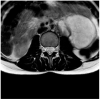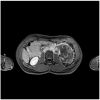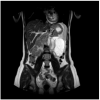Imaging of Ganglioneuroma: A Literature Review and a Rare Case of Cystic Presentation in an Adolescent Girl
- PMID: 37443583
- PMCID: PMC10341194
- DOI: 10.3390/diagnostics13132190
Imaging of Ganglioneuroma: A Literature Review and a Rare Case of Cystic Presentation in an Adolescent Girl
Abstract
Retroperitoneal ganglioneuroma is a rare neuroectodermal tumor with a benign nature. We performed a literature review among 338 studies. We included 9 studies, whose patients underwent CT and/or MRI to characterize a retroperitoneal mass, which was confirmed to be a ganglioneuroma by histologic exam. The most common features of ganglioneuroma are considered to be a solid nature, oval/lobulated shape, and regular margins. The ganglioneuroma shows a progressive late enhancement on CT. On MRI it appears as a hypointense mass in T1W images and with a heterogeneous high-intensity in T2W. The MRI-"whorled sign" is described in the reviewed studies in about 80% of patients. The MRI characterization of a primitive retroperitoneal cystic mass should not exclude a cystic evolution from solid masses, and in the case of paravertebral location, the differential diagnosis algorithm should include the hypothesis of ganglioneuroma. In our case, the MRI features could have oriented towards a neurogenic nature, however, the predominantly cystic-fluid aspect and the considerable longitudinal non-invasive extension between retroperitoneal structures, misled us to a lymphatic malformation. In the literature, it is reported that the cystic presentation can be due to a degeneration of a well-known solid form while maintaining a benign character: the distinguishing malignity character is the revelation of immature cells on histological examination.
Keywords: CT; MRI; backpain; cystic mass; ganglioneuroma; retroperitoneal mass.
Conflict of interest statement
The authors declare no conflict of interest.
Figures





Similar articles
-
Imaging of retroperitoneal ganglioneuroma.Eur Radiol. 2001;11(6):940-5. doi: 10.1007/s003300000698. Eur Radiol. 2001. PMID: 11419166
-
Adrenal ganglioneuroma. A neoplasia to exclude in patients with adrenal incidentaloma.Acta Chir Belg. 2007 Nov-Dec;107(6):670-4. doi: 10.1080/00015458.2007.11680144. Acta Chir Belg. 2007. PMID: 18274182
-
Imaging diagnosis of retroperitoneal ganglioneuroma in childhood.Pediatr Radiol. 2001 Feb;31(2):106-10. doi: 10.1007/s002470000381. Pediatr Radiol. 2001. PMID: 11214677
-
Advanced MRI manifestations of trigeminal ganglioneuroma: a case report and literature review.BMC Cancer. 2016 Aug 30;16(1):694. doi: 10.1186/s12885-016-2729-8. BMC Cancer. 2016. PMID: 27576442 Free PMC article. Review.
-
Tips to facilitate a preoperative diagnosis of adrenal ganglioneuroma. Report of a challenging experience and review of the literature.Ann Ital Chir. 2016 Feb 10;87:S2239253X16024208. Ann Ital Chir. 2016. PMID: 27595615 Review.
Cited by
-
Adolescent thoracic scoliosis due to giant ganglioneuroma: a two-case report and literature review.Nagoya J Med Sci. 2024 Nov;86(4):711-719. doi: 10.18999/nagjms.86.4.711. Nagoya J Med Sci. 2024. PMID: 39780926 Free PMC article. Review.
-
A rare presentation of a sacral mass: Ganglioneuroma.Radiol Case Rep. 2025 Jun 9;20(9):4252-4256. doi: 10.1016/j.radcr.2025.05.055. eCollection 2025 Sep. Radiol Case Rep. 2025. PMID: 40547939 Free PMC article.
-
Rare Presentation of Cervical Ganglioneuroma: A Case Report.Cureus. 2025 Jul 21;17(7):e88427. doi: 10.7759/cureus.88427. eCollection 2025 Jul. Cureus. 2025. PMID: 40851715 Free PMC article.
References
Publication types
LinkOut - more resources
Full Text Sources

